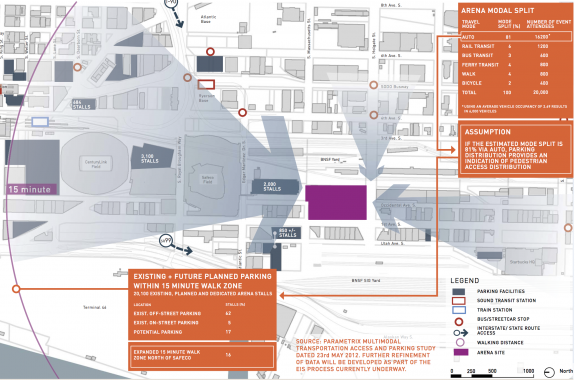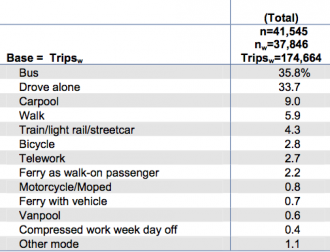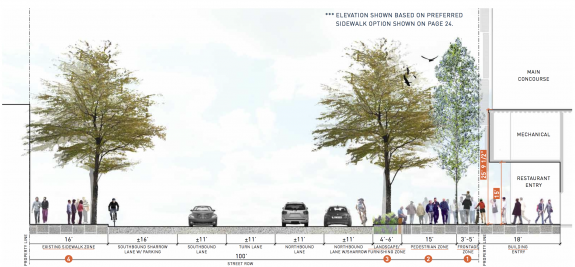
The proposed Sonics Arena in Sodo goes before the Downtown Design Review Board tonight (5:30 p.m. in the Bertha Knight Landes Room at Seattle City Hall). Regardless of what you think of the architectural design, this is a great opportunity to kick-start a serious conversation about bicycle access to the city’s stadiums.
First off, the design documents predict that only two percent of fans will arrive at the arena via bike, four percent by walking and a stunningly low 13 percent via transit. They predict 81 percent will arrive by car.

This is almost certainly far off in all respects. For example, a 2011 Commute Seattle report showed that only 56 percent of people who commute downtown to work do so by car. 47 percent travel by public transit, 4.3 percent bike and 8.3 walk. UPDATE: Zach Shaner points out below that I was looking at a slightly different table. The actual numbers are: transit 42.3%, drive alone 35.2%, rideshare 9.6%, walk 5.9%, bike 2.8%, other 4.2%. He also says the arena estimates are based on data from the other stadiums. But there’s no reason to think that better access couldn’t change these figures.
Perhaps this seems like nitpicking, but a big concern for the stadium is car parking. Concentrating more on providing safe and easy access to transit hubs and providing safe and inviting bike lanes could go a long way in easing these parking concerns.
Plus, an endless stream of fans sporting Sonics jerseys as they walk, bike, and fill buses and trains on their way to the game is far better for team spirit than a traffic jam!
Not all the access issues are under the purview of the arena designers. This will require city action, as well as help from the other stadiums and the Port of Seattle. Here’s an example:
This is a look at 1st Ave in front of the stadium. Now, architects only really have control over the sidewalk and building front design. But it’s not hard to imagine why this street design might discourage people from cycling to games. There is definitely space for a protected bike lane here, which would have the added advantage of improving all the crossings for people walking and giving people on the sidewalk more space from speeding cars. This is especially important for, say, a large crowd of inebriated basketball fans…
There is also immense potential for changes to improve access to all stadiums from Pioneer Square and the International District. For example, there is an existing footbridge from 4th and Weller to the Century Link Field parking lot that is utterly underutilized. Right now, it simply feels like it only goes to the parking lot. But with fairly little work (and maybe some ramps for direct cycling and ADA access without needing the elevator), a trail could be built that makes it intuitive, easy and safe to access the stadiums and Pioneer Square.
Events like Portland’s Bike to Blazers demonstrate the potential for cycling and basketball (or any sport, for that matter) to be a powerful combo. After all, when you bike, walk and take transit, getting to the game can be fun, too.
What ideas do you have for encouraging bike access to the stadiums?
Here’s the full design proposal document:









Comments
19 responses to “Why the Sonics Arena should take bike access seriously”
What are the numbers in Portland?
The stadium area is sad joke for cyclists. My commute travels from West Seattle to the ID for work, and its unmarked, dangerous and thrown in as an after thought. I Crossing from 1st to 4th is a nightmare, unless you travel as far north as king street. Edgar Martínez dr is a glorified on-ramp for trucks and cars where speeds are out of control. The only suitable route is via the sidewalk, which although wide is useless due to the crossings lacking buttons ( due to police acting as traffic control on game days ) The alternative route created on Royal Brougham is a dangerous narrow winding curve, which most cyclists avoid. 4th ave in the same area is a wasteland with no bike lanes and no west sidewalks, its also treated as a on ramp for cars and the speeds reflect it.
Some quick points of clarification. Your table of commute modes was pulled from Table 3, which was a summary of 7-day travel behavior with multiple entries accepted (notice that it sums to 128%). So for Table 3 for example, 4.3% of respondents rode a bike at least once during that week. For primary *weekday commute modeshare*, the numbers should be pulled instead from Table 4. The relevant 2010 numbers are then transit 42.3%, drive alone 35.2%, rideshare 9.6%, walk 5.9%, bike 2.8%, other 4.2%.
In addition, the 81% number they used for modeling SOV share was based upon real data from Safeco and CenturyLink fields. The 81% driving rate has a very high occupancy rate (~3 ppl/car), so that’s how they arrive at a sold-out basketball game only adding 6,000 cars.
All that said, a 20% non-driving share for (mostly after-hours and weekend) sporting events is impressive, and the traffic impact report does give significant attention to the eventual effects of Link extensions to Northgate, Lynnwood, Des Moines, and Bellevue/Redmond. Right now there’s not a safe way to walk or bike from King St Station, Stadium or SODO Link stations to Occidental/Holgate, and IMO that should be priority one in any design.
Thanks, Zach. I made the appropriate changes to the table and story above.
They do have some control over design in the right-of-way, and they are showing wider sidewalks at the expense of space for bike lanes. They could pull the building back to get the wider sidewalks instead of pushing the curb out. The proposal shows only 2% arriving to events by bike, but even that is 400 bikes. Their renderings show lots of bikes on streets, but sadly, very little provision actually on site for bike parking. Looks like on-sidewalk racks for about 25 bikes, some of it under building overhangs. They do show generous plaza space for a skatepark, oversize board games, sand-court volleyball, outdoor ice rink for 160 skaters, or ballroom dancing ! The “Sustainability” section includes token permeable paving and rain gardens (supposedly infiltrating into the impermeable tideflat muck) and greenwashing with vine walls, but says not a word about how the facility could promote sustainable transportation. Traffic lanes get narrowed. 11′ with sharrows north bound on 1st, and 16′ with parking and sharrows south bound. Does not quite square up with the Bike Master Plan Update for 1st Ave S.
I’m also assuming that if the Safeco garage is used for basketball parking, as many of the renderings show, that its bike room would also be accessible. It holds about 150 bikes IIRC, and it is BY FAR the best way to get to/from a Mariner’s game.
Thanks for posting this. This is an underserved bicycle market for a number of reasons, one of which being that many of the bicycle advocates in this town seem to be averse to something as bourgeois as professional sports. Living in West Seattle, my preferred mode of transport to Seahawks and Sounders games, not to mention the odd U2 concert is definitely by bike. Forget about parking, forget about traffic. They should really be selling this up, not fighting it, or ignoring it based on national best practices. With three stadiums there should be a real stadium non-motorized strategy that could start by creating a meaningful parking hub. I don’t know about recommending specific lanes or anything, but certainly signalization could be improved. I have seen a couple of those peak summer Sounders games where there were so many bikes, no one knew where else to park. There were bikes locked up on all kinds of fences and stuff.
Agreed. I’ve also witnessed the beyond-capacity bike parking during Sounders games.
As for the bike lanes, I am just trying to throw out ideas. Even with the wider sidewalks, there would be 60′ curb-to-curb, which is massive. If a two-way cycle track were created, there would still be room for five 9.5′ lanes (two in each direction plus the turn lane) and no parking. Or you could do a parking-separated cycle track and four 10′ lanes with bus islands and turn lanes at major intersections (my personal favorite). All these would preserve freight mobility, maybe even enhancing it during game days by providing people with more options other than driving and clogging the streets.
I’m sure there are a lot more options, as well. I’m all ears.
It’s a good thing we’re building a Mountains to Sound Trail connection across I-5 to make it easier to get to the general area from southeast Seattle and the Eastside, even if Royal Brougham sucks. Oh wait, that connection isn’t in the new Bike Master Plan.
An additional reason for better and protected bicycle right-of-ways is that games draw a lot of drivers from outside the city, who are unused to driving in close proximity to bicycles. Drivers who commute daily have learned (poorly perhaps, but somewhat) to drive carefully around bicycles. Game days bring in less aware or friendly drivers. I stay the heck away from downtown and SODO when there is a game.
For many years I’ve used a bicycle to get from W.Seattle to the stadiums and back. When the family needed to go also, I’d compromise by running them down by car, with the bike on the rack, then park the car in a free spot, then ride the bike back in. Or encourage everyone to do the bus. Anything to avoid the long waits to get out of the area. If they’d make it *just* a little easier for us to get in and out, there would be improvements in many ways for the quality of life around here.
If anyone things they’re going to consider cycle tracks in this area you’re kidding yourself. With semi-trucks needing the roads in and around this area the powers that be would be foolish to reduce lanes to 9.5′ width. Truck traffic is going to take priority over bicycles in this area as it should.
Putting cars, trucks and bikes in “shared” lanes in this area is the worst possible approach. A plan that separates bikes from trucks and cars, makes it easy and fun to leave the car at home, and routes cars away from truck corridors – that would make sense.
I agree trucks and bicycles sharing lanes isn’t the safest idea in the world. But I also believe that area of town should be prioritized toward trucks due to their importance for the economy. I am totally against cycle tracks in the area if it means 9.5′ lanes. Driving narrow lanes like those on the Aurora Bridge in a regular car is scary enough, let alone with semi-trucks all over. If there’s room (and funding for that matter) to put in cycle tracks and what not then great! Less accidents. Less angst between cyclists and motorists. But 9.5′ lanes in a major port district? No way.
Sorry, don’t quote my numbers. I’m not a traffic engineer or anything. I’m just doing quick math based on the little I know.
The point is: There’s 60′ of road even after the sidewalk widening and trees. I’m sure we can make some space for people to be able to bike safely without bringing freight traffic to a standstill.
Bike parking for three nearly adjacent stadiums plus exhibition hall:
Consider innovative yet proven designs for bike storage at major destinations.
For example, secure bike parking at Kasai Station, Tokyo.
The above-ground profile is about the size of a conventional enclosed single-bike locker. A robot station unit can handle 180 bikes, dispensing a bike takes 20-30 seconds (Kasai Station has about 52 units). The system has been in service more than five years.
[ http://www.japanprobe.com/?p=4347 ]
[ http://www.fnn-news.com/news/headlines/articles/CONN00130127.html ]
Costs 2,600 Yen ($29 USD) per month. [27 Nov. 2012] [ http://www.youtube.com/watch?v=Nswm0U6ZjFY ] $1.61 per single use.
The robot stations (silos) could be variously distributed for maximum use. After a succesful pilot project, with similar distributions at major destinations along the Sound Transit Link system, economies of scale could be realized.
.
I agree with Zach and JWT that getting to the stadiums by bike from West Seattle is a practical option, and the Safeco garage is a good place to park with 150 of the Arena proponents’ low estimate of 400 bikes. one of our West Seattle Bike Connections members rides to 3o Mariners games a season and parks there. Where do the other 250 go? Also really, truly agree that trucks need free access and priority in SODO. This is industrial and port land, essential to our economy and living wage jobs, and it can’t be relocated away from our only deep water seaport. At the same time, it is a through route for bike transportation, and we need space to co-exist safely. Many bike fatalities here are due to collisions with big trucks. The bike master plan update calls for separation of bike lanes or cycle tracks, and there is room now on 1st Ave. The Arena project is removing a whole street, Occidental, and should not be allowed to remove public right-of-way on 1st Ave for the sake of their crowds of customers paying lots of money to them to see the games. They should make room on their own land, and we taxpayers should retain our rights of way. Or, they should find another location for their arena. Or, pay for good separated bike and truck routes on nearby streets as part of their mitigation of impacts.
If there aren’t separated bike routes there in the first place, why should the Sonics Arena folks be all the sudden obligated to building a cycle track or something of that nature? The SODO Trail is only 2-3 blocks east, too.
In a hilly city, we have to accept that there are some of the destinations for which a direct bike route may not be possible. But on the other hand, city has made some of the routes so comfortable for bikes and so many users are getting attracted by them.